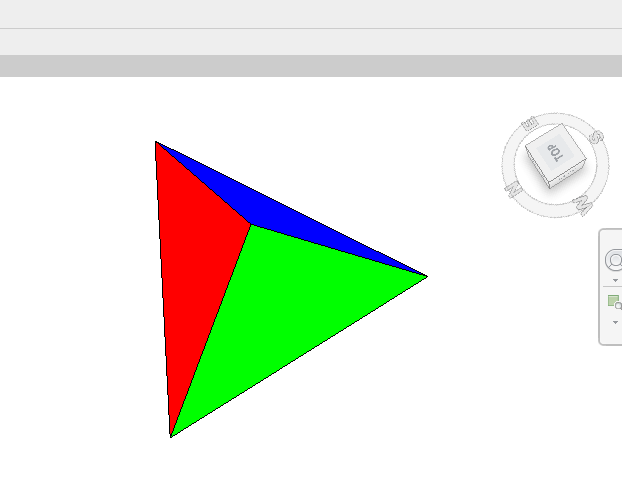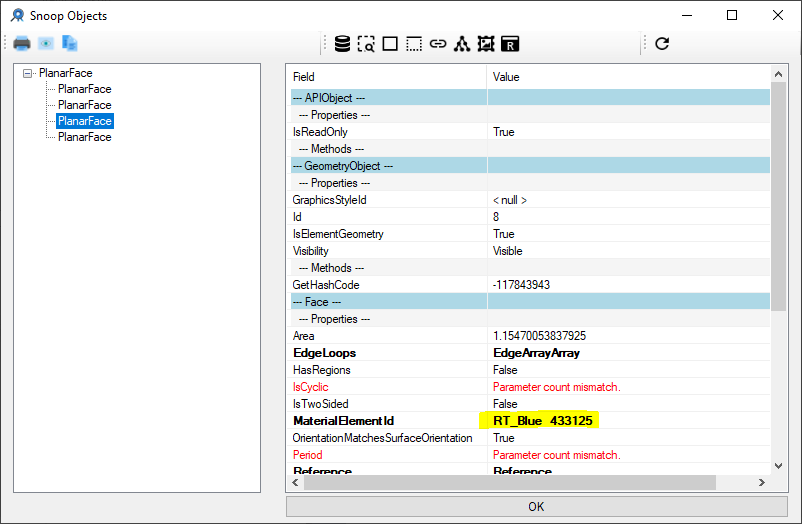Point Clouds, Coloured Triangles and Faces
Let's look at accessing point cloud points and colouring individual triangles and faces:
- Assigning material to each face
- DirectContext3D colorized triangles
- Pick and access point cloud points
Assigning Material to Each Face
Richard RPThomas108 Thomas has been solving the majority of tricky questions in the Revit API discussion forum for quite some time.
Among many others, he addressed using different material on each face of a tessellated shape:
Question: I am creating a complex tessellated shape, in which I am trying to use more than one material. Essentially, I am trying to paint each face with its own colour.
However, the end result seems to use just one material for the entire shape (I think it's the material that I've used for the first face).
The API allows me to specify the material id on a face level – the TesselatedFace constructor accepts the vertices and the material.
I am currently trying to specify the colour of each face by creating a new material.
Is there a more straightforward way to paint individual faces of a tessellated shape?
Answer: I don't see the same issue in Revit 2022:

Private Function Obj_210816c( ByVal commandData As Autodesk.Revit.UI.ExternalCommandData, ByRef message As String, ByVal elements As Autodesk.Revit.DB.ElementSet) As Result Dim UIDoc As UIDocument = commandData.Application.ActiveUIDocument If UIDoc Is Nothing Then Return Result.Cancelled Else Dim IntDoc As Document = UIDoc.Document Dim Mats As New List(Of String) Mats.Add("RT_Red,255,0,0") Mats.Add("RT_Green,0,255,0") Mats.Add("RT_Blue,0,0,255") Mats.Add("RT_Cyan,0,255,255") Dim FEC As New FilteredElementCollector(IntDoc) Dim ECF As New ElementClassFilter(GetType(Material)) Dim MatsFound As List(Of Element) = FEC.WherePasses(ECF) _ .ToElements.Where(Function(n) n.Name.StartsWith("RT_")) _ .ToList Dim NewMats As ElementId() = New ElementId(3) {} Using tx As New Transaction(IntDoc, "Add materials") If tx.Start = TransactionStatus.Started Then Dim Commit As Boolean = False Dim Ix As Integer = 0 For Each item As String In Mats Dim Str As String() = item.Split(New Char() {","}, StringSplitOptions.None) Dim M As Element = MatsFound.FirstOrDefault( Function(x) x.Name = Str(0)) If M Is Nothing Then NewMats(Ix) = Material.Create(IntDoc, Str(0)) Commit = True IntDoc.Regenerate() Dim M1 As Material = IntDoc.GetElement(NewMats(Ix)) M1.Color = New Color(CByte(Str(1)), CByte(Str(2)), CByte(Str(3))) Else NewMats(Ix) = M.Id End If Ix += 1 Next If Commit Then tx.Commit() Else tx.RollBack() End If End If End Using Dim Size As Double = 1 Dim v1 As New XYZ((8 / 9) ^ 0.5, 0, -1 / 3) Dim v2 As New XYZ(-(2 / 9) ^ 0.5, (2 / 3) ^ 0.5, -1 / 3) Dim v3 As New XYZ(-(2 / 9) ^ 0.5, -(2 / 3) ^ 0.5, -1 / 3) Dim v4 As New XYZ(0, 0, 1) v1 *= Size v2 *= Size v3 *= Size v4 *= Size Dim F As XYZ(,) = New XYZ(3, 2) {{v4, v1, v2}, {v4, v2, v3}, {v4, v3, v1}, {v1, v2, v3}} Dim TSB As New TessellatedShapeBuilder() TSB.OpenConnectedFaceSet(True) For i = 0 To 3 Dim EID As ElementId = NewMats(i) TSB.AddFace(New TessellatedFace( {F(i, 0), F(i, 1), F(i, 2)}.ToList, EID)) Next TSB.CloseConnectedFaceSet() TSB.Build() Using tx As New Transaction(IntDoc, "Tetrahedron") If tx.Start = TransactionStatus.Started Then Dim DS As DirectShape = DirectShape.CreateElement( IntDoc, New ElementId(BuiltInCategory.OST_GenericModel)) DS.AppendShape(TSB) tx.Commit() End If End Using Return Result.Succeeded End Function
TessellatedShapeBuilder.GraphicsStyleId will be set for the whole shape, i.e., it can have Category with Material.
This code sets a material per face, originally for Revit 2022, and still works in Revit 2023.
In realistic visual style, the colour is taken from the Appearance Asset Colour which has not been set for the four materials created above (this can be changed via the assets of the material). However, each face is set to a different material. This can also be seen in RevitLookup:


Thank you, Richard, for the useful sample code and explanation!
DirectContext3D Colorized Triangles
Tamas Deri explored and answered his own question of how to create DirectContext3D colorized triangles:
Question: I'm having trouble applying colors to triangles that are shown via a DirectContext3DServer.
I use a ColorWithTransparency object as a basis.
Lines working fine, but here is the issue with triangles:
I can apply the color via the EffectInstance, but only if I set it's Emissive Color through SetEmissiveColor.
If I set all its other colors like, Color, DiffuseColor, SpecularColor or AmbientColor, it stays black.
Changing transparency works fine.
The biggest issue if I'd like to apply the colors per vertices it won't work.
I'm using VertexFormatBits.PositionNormalColored, and set for instance ColorWithTransparency(255,0,0,200) as it's color, but all triangles will be transparent black.
Any idea what could be the issue? No exceptions thrown, all buffers are valid, the geometries are being shown, but without the right color applied.
Answer: I tried to put together a reproducible case, and I've just found out what the issue was. I left a line in the code which set the EffectInstance's transparency, and I think if any property of the EffectInstance is set, then it overrides all vertex properties. That's why the vertex colors got ignored, and it falled back to transparent black. Once I removed that line and kept only the just-constructed EffectInstance it worked as intended.
Here is a partial code that updates the buffers if it is neccessary. The rest is similar to what is available from other sources regarding DirectContext3D.
def update_buffer(self):
if self.penetrations is None: return False
try:
lines = []
triangles = []
colors = []
for pen_item in self.penetrations:
if pen_item.proposed:
primitives = pen_item.proposed.get_wireframe()
else:
primitives = pen_item.current.get_wireframe()
lines.extend(primitives[0])
triangles.extend(primitives[1])
colors.append(pen_item.status_color)
tri_f_bits = dc.VertexFormatBits.PositionNormalColored
tri_vertex_format = dc.VertexFormat(tri_f_bits)
tri_effect_instance = dc.EffectInstance(tri_f_bits)
# If you try to handle transparency globally it will also
# overrides vertex colors, and overrides them to black
# tri_effect_instance.SetTransparency(0.8)
tri_vertex_buffer_size = \
dc.VertexPositionNormalColored.GetSizeInFloats() \
* len(triangles) * 3
tri_vertex_buffer = dc.VertexBuffer(tri_vertex_buffer_size)
tri_index_buffer_size = \
dc.IndexTriangle.GetSizeInShortInts() * len(triangles)
tri_index_buffer = dc.IndexBuffer(tri_index_buffer_size)
tri_vertex_buffer.Map(tri_vertex_buffer_size)
tri_index_buffer.Map(tri_index_buffer_size)
tri_vertex_stream_p = \
tri_vertex_buffer.GetVertexStreamPositionNormalColored()
tri_index_stream_p = tri_index_buffer.GetIndexStreamTriangle()
for triangle in triangles:
triangle_index = triangles.index(triangle)
first_idx = triangle_index * 3
tri_vertex_stream_p.AddVertex(dc.VertexPositionNormalColored(
triangle[1], triangle[0], colors[triangle_index / 12]
))
tri_vertex_stream_p.AddVertex(dc.VertexPositionNormalColored(
triangle[2], triangle[0], colors[triangle_index / 12]
))
tri_vertex_stream_p.AddVertex(dc.VertexPositionNormalColored(
triangle[3], triangle[0], colors[triangle_index / 12]
))
tri_index_stream_p.AddTriangle(dc.IndexTriangle(
first_idx,
first_idx + 1,
first_idx + 2
))
tri_vertex_buffer.Unmap()
tri_index_buffer.Unmap()
self.triangle_buffer = (
tri_vertex_buffer,
tri_vertex_buffer_size,
tri_index_buffer,
tri_index_buffer_size,
tri_vertex_format,
tri_effect_instance,
dc.PrimitiveType.TriangleList,
0,
len(triangles)
)
line_f_bits = dc.VertexFormatBits.PositionColored
line_vertex_format = dc.VertexFormat(line_f_bits)
line_effect_instance = dc.EffectInstance(line_f_bits)
line_vertex_buffer_size = \
dc.VertexPositionColored.GetSizeInFloats() * len(lines) * 2
line_vertex_buffer = dc.VertexBuffer(line_vertex_buffer_size)
line_index_buffer_size = \
dc.IndexLine.GetSizeInShortInts() * len(lines)
line_index_buffer = dc.IndexBuffer(line_index_buffer_size)
line_vertex_buffer.Map(line_vertex_buffer_size)
line_index_buffer.Map(line_index_buffer_size)
line_vertex_stream_p = \
line_vertex_buffer.GetVertexStreamPositionColored()
line_index_stream_p = line_index_buffer.GetIndexStreamLine()
for line in lines:
line_index = lines.index(line)
first_idx = line_index * 2
line_vertex_stream_p.AddVertex(dc.VertexPositionColored(
line.GetEndPoint(0), colors[line_index / 12]
))
line_vertex_stream_p.AddVertex(dc.VertexPositionColored(
line.GetEndPoint(1), colors[line_index / 12]
))
line_index_stream_p.AddLine(dc.IndexLine(
first_idx,
first_idx + 1
))
line_vertex_buffer.Unmap()
line_index_buffer.Unmap()
self.line_buffer = (
line_vertex_buffer,
line_vertex_buffer_size,
line_index_buffer,
line_index_buffer_size,
line_vertex_format,
line_effect_instance,
dc.PrimitiveType.LineList,
0,
len(lines)
)
self.update_flag = False
return True
except:
return False
At least there is some python example of DirectContext3D :-)
I also managed to figure out why the vertex colors were not applied. It is related to the EffectInstance, but it has nothing to do with its colors. The problem was that I've been using an EffectInstance created as EffectInstance (VertexFormatBits.PositionNormalColored), even though my display style was not shaded. This made all my triangles black on non-shaded views, but they did work fine on shaded views. So I added the following lines:
if any([
display_style == DB.DisplayStyle.Shading,
display_style == DB.DisplayStyle.ShadingWithEdges
]):
tri_effect_instance = dc.EffectInstance(
dc.VertexFormatBits.PositionNormalColored
)
else:
tri_effect_instance = dc.EffectInstance(
dc.VertexFormatBits.PositionColored
)
Now it works on all views as expected, and I was able to keep the vertices as VertexPositionNormalColored in all cases. The EffectInstance did the trick by itself.
Many thanks to Tamas for the good research and sample code!
Pick and Access Point Cloud Points
Richard RPThomas108 Thomas solved two more tricky point cloud related questions as well.
The latest explains how to address
the definition of work plane for picking point of point cloud in orthographic 3D view.
In summary, Richard recommends using the Selection.PickObject method specifying ObjectType.PointOnElement and shares code to:
- Get the minimum point of the UIView from UIView.GetZoomCorners
- Set up a work plane using view direction and min point from above; note that since the user can rotate the view during selection of points, this invalidates the work plane position for point selection. So, I'm locking the view orientation after the projection plane is set.
- Pick the point on the plane
- Filter the cloud by creating a box aligned with the view direction around the picked point
- Transform the filtered cloud points to model space and project them onto plane and find nearest to original picked point
There is a lot more to it than it sounds, though...
Before that, he also addressed how to access point cloud points through API:
Question: I imported an .rcs point cloud to Revit 2022 using Insert > Point Cloud.
I would like to access its points and colors through Revit API.
For that, I found the PointCloudInstance.GetPoints method.
Its third input is numPoints, representing the number of points which should be extracted from the point cloud.
However, this input cannot be larger than 1 million.
And if I try to make it larger, it raises an error message: 'It can be from 1 to 1000000.'
Does this mean that for any point cloud we import to Revit, we can only access its first 1 million points through Revit API, and those beyond are inaccessible?
Answer: I think the statement regarding how many points you can access is incorrect.
Yes, there is a limit, but you can process the cloud in blocks by adjusting the filter limits and thus access all the points, not just the limit of one block.
A confusing aspect is the averageDistance:
Desired average distance between "adjacent" cloud points (Revit units of length). The smaller the averageDistance the larger number of points will be returned up to the numPoints limit. Specifying this parameter makes actual number of points returned for a given filter independent of the density of coverage produced by the scanner.
What is the lowest number I can set this to, the limit of the scanner or smallest possible +ve double value? I think it should be an optional parameter whereby it just returns all the points for an area up to the max number of points limit. It says: "Specifying this parameter...", making it sound like it is optional, but it doesn't tell me it can be null for example.
I would probably split the cloud up into blocks and test the number of points has not reached the limit for each. If it has reached the limit for a given block, then subdivide that block up into more blocks.
Note:
If there are more points in the cloud passing the filter than the number requested in this function, the results may not be consistent if the same call is made again.
So, if the amount of points is less than the max number then I assume you have all the points for that block.
Additionally the PointCollection has the member GetpointBufferPointer; this could then provide a faster way to count the points in each block to establish if the block needs further subdividing.
Many thanks again to Richard for his helpful advice and great expertise!